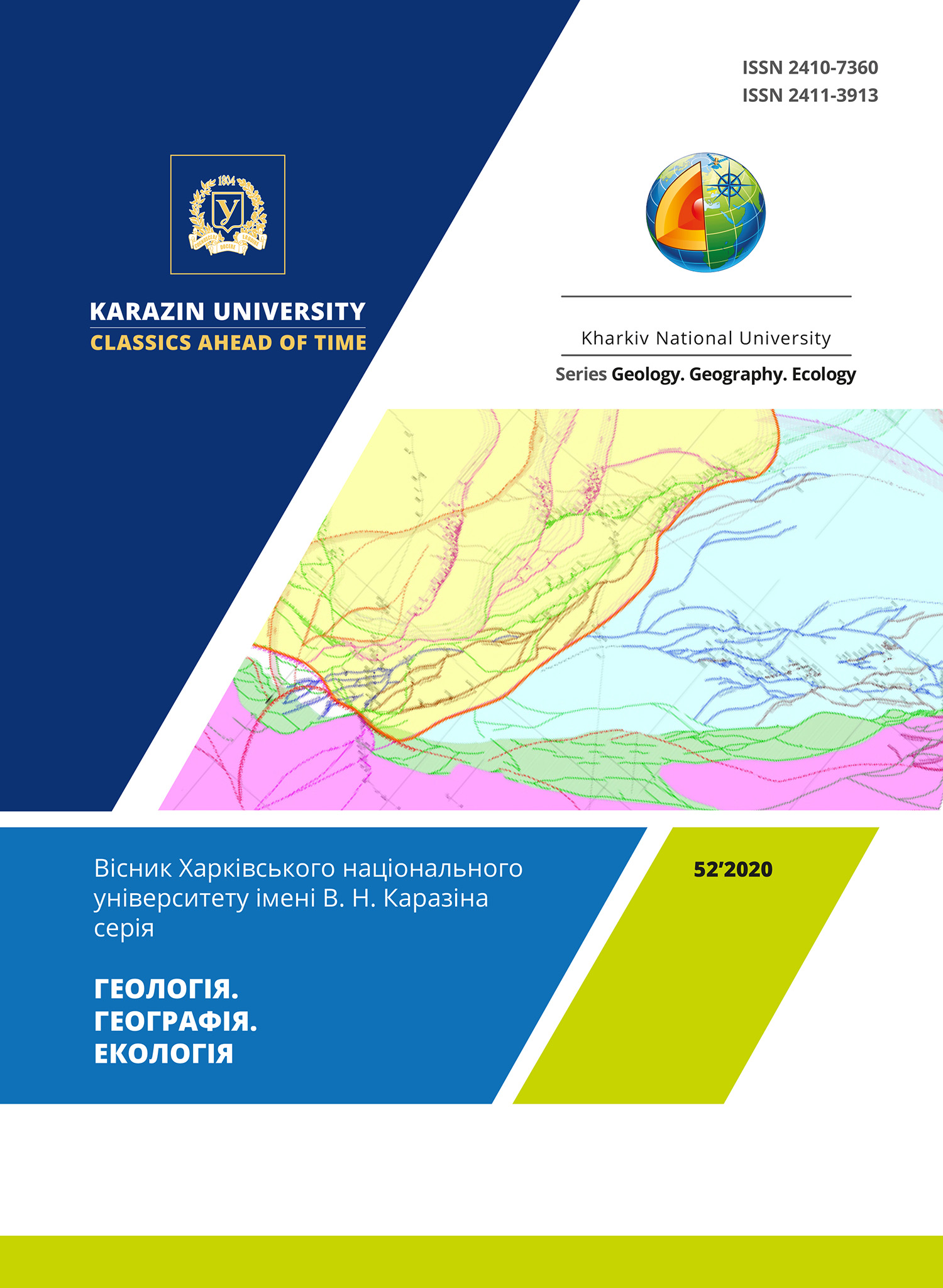Методичні підходи до визначення межі приміської зони міста Одеса
Анотація
В статті висвітлено актуальність дослідження щодо питання визначення меж приміських зон. Розглянуто варіанти делімітації меж за існуючими законодавчими актами. Крім того аналіз досліджень і публікацій учених дав можливість окреслити й інші підходи до визначення меж приміської зони й порівняти результати з зазначеною межею приміської зони в Генеральному плані м. Одеси. Таким чином, проведено розрахунки та візуалізовано, за допомогою програмного забезпечення ArcGIS Pro, кілька варіантів визначення межі приміської зони міста Одеса, а саме застосовано методичний підхід з розрахунку індексу концентрації населення, результати якого підтвердили наші припущення щодо концентрації населення в приміській зоні. Другий методичний підхід з розрахунку гравітаційної моделі на основі параметру відстані дав можливість зробити висновок про вирішальну роль доступності населених пунктів до міста-центру. В третьому підході, за допомогою гравітаційної моделі Г. Кареєма, яка поєднує параметр відстані та демографічний потенціал центрів дослідження, визначили межі приміської зони міста Одеси, які максимально корелюють з зазначеною межею в Генеральному плані.
Отже проведені досліджені дають можливість стверджувати, що одним із важливих показників у визначенні межі приміської зони є часова ізохрона, тобто доступність до міста, яка, в більшості випадків, формує багатоаспектні зв’язки міста і приміської зони. Делімітація меж приміських зон міст дасть можливість цілеспрямованого планування територій, організації ефективної системи господарювання, встановлення географічних особливостей розвитку міста, використання для міської забудови територіальних ресурсів передмістя, взаємозв’язок розвитку міста та його приміської зони.
Завантаження
Посилання
Law of Ukraine «Regulation of urban development activitie» 3038-VI (2011). Information of The Verkhovna Rada Of Ukraine. 34, 343. Available at: https://zakon.rada.gov.ua/laws/show/3038-17.
Ministry Of Regional Development (2018). Planning and development of territories: DBN B. 2. 2-12: 2018. Kyiv, 230.
State Building of Ukraine (2002) City building. Planning and development of urban and rural settlements: DBN 360-92** [Valid from 2002.04.19]. Kyiv, 67.
Andrievsky I. (2013) Problems of urban agglomerations. Available at: http://vo-vremya.ru/stati/problemyi_gorodskih_aglomeratsiy1301.
Bilokon Yu. M. (2003). Regional planning (theory and practice). Monograph. Kyiv, Logos Publ., 246.
Bilokon Yu. M. (2005). Modern trends in the development of master plans for large cities. Experience and prospects of development of cities of Ukraine. Kyiv: Dipromisto, 5-14.
Bogorad D. I. (1966). Urban agglomerations of the Ukrainian SSR. Main provisions and conclusions. Kyiv, NIISP Gosstroya of the Ukrainian SSR, 73.
General plan of the city of Odessa. Available at: https://service.ombk.odessa.ua/portal/apps/webappviewer/index.html?id=b31cc5f267c740aca33f5893c3dc9c45
Gladkiy A.V. (2012). Features of delimitation of monocentric industrial agglomerations of Ukraine (on the example of Lviv and Odessa agglomerations). Economic and social geography: Сollection of scientific papers. Kyiv, 65, 161-173.
Gladkiy O. V., Ishchuk S. I. (2014). Geography of cities. Geourbanistics. Taras Shevchenko national University of Kyiv. Moscow, 300.
Golikov A. P. (2003). Economic and geographical modeling of world economic processes. Kharkiv, Kharkiv national University, 104.
Dnistryanska N. I., Dnestryanskiy M. S. (2013). Very small settlements in Lviv region: social and geographical potential and prospects of development]: monograph. Lviv, House of Ivan Franko LNU, 198.
Ibatullin Sh. I. (2007). Defining the boundaries and directions of urban agglomeration development. Land Management and cadaster, 2, 25-36.
Ishchuk, S. I. (2005). Kiyv economic agglomeration: experience of regional management: monograph. Kiev: Horizons Publ., 239.
Lappo G. M. (1997). Geography of cities. Moscow, 480.
Lappo G. M. (1987). Cities on the way to the future. Moscow: Mysl, 236.
Olynik V., Hropot S.(2017). The Role and purpose of the suburban zone of a large city. Regional policy: history, historical and legal foundations, architecture, urbanism. Сollection of scientific papers in 3 parts. Kiev-Ternopil, 2, 202-205.
Palekha Yu. M. (2015). Experience and prospects of development of cities of Ukraine, 28, 78-88. Available at: http://nbuv.gov.ua/UJRN/dprmu_2015_28_11
Paleha Yu. M. (2008). Research of the cost of territories of localities – a new direction in the Ukrainian socio-economic geography. Geography in the information society: Collection of scientific papers. Kiyv, 2, 284-286.
Potaev G. A. (2009). Ecological renovation of cities: monography. Minsk, 173, 30.
Pilipenko I. A. (2015). Socio-geographical periphery: concept, parametrization, delimitation: monograph. Kherson. 264.
O. G. Topchiev, I. I. Kondratyuk, V. V. Yavorskaya, V. D. Oleinik, L. V. Khomich et al. (2012). Odessa region: prerequisites for the formation, structure and territorial organization of the economy. Odessa national University named after I. I. Mechnikov. Odessa: Astroprint, 336.
Yatsenko V. O. (2015). Suburban area – retrospective realist, perspective. Modern problems of architecture and urban planning: Collection of scientific papers. Kyiv, KNUBA, 40, 331-340.
Limits on the use of suburban areas. Available at: http://kadastrua.ru/teritorialnij-zemleustrij/66-mezhi-koristuvannya-primiskikh-zon.html
Banski J. (2005). Suburban and peripheral rural areas in Poland: the balance of development in the transformation period. Geografický časopis, 57 (2), 117–130.
Dinić M., Đurić J., Mitković P. (2010). Rural settlements in suburban and scape of the post-socialist city. Landscape Transformations: International interdisciplinary student conference. Prag, 136–144.
Dinić M., Mitković P. (2016). Suburban design: from “bedroom communities” to sustainable neighbor hoods. Geodetsk iVestnik, 60 (1), 98–113.
Dunham-Jones E., Williamson J. (2011). Retrofitting Suburbia, Updated Edition: Urban Design Solutions for Redesigning Suburbs. New York, 288.
Fisher T. (2012). Differentiation of growth processes in the peri-urban region: an Australian case study. Urban Studies, 40 (3), 551–565.
Mumford L. (2006). Grad u istoriji: njegov postanak, njegovo menjanje, njegovi izgledi. Zagreb, 104.
Stanilov K., Scheer B. (2007). Suburban Form: An International Perspective. London, 25–53.
Stanilov K., Sykora L. (2015). Confronting Suburbanization: Urban Decentralization in Post socialist Central and Eastern Europe. Chichester, 256–295.
Tsenkova S., Nedović-Budić Z. (2018). The urban mosaic of post-socialist Europe: space, institutions and policy. New York, 3–20.





